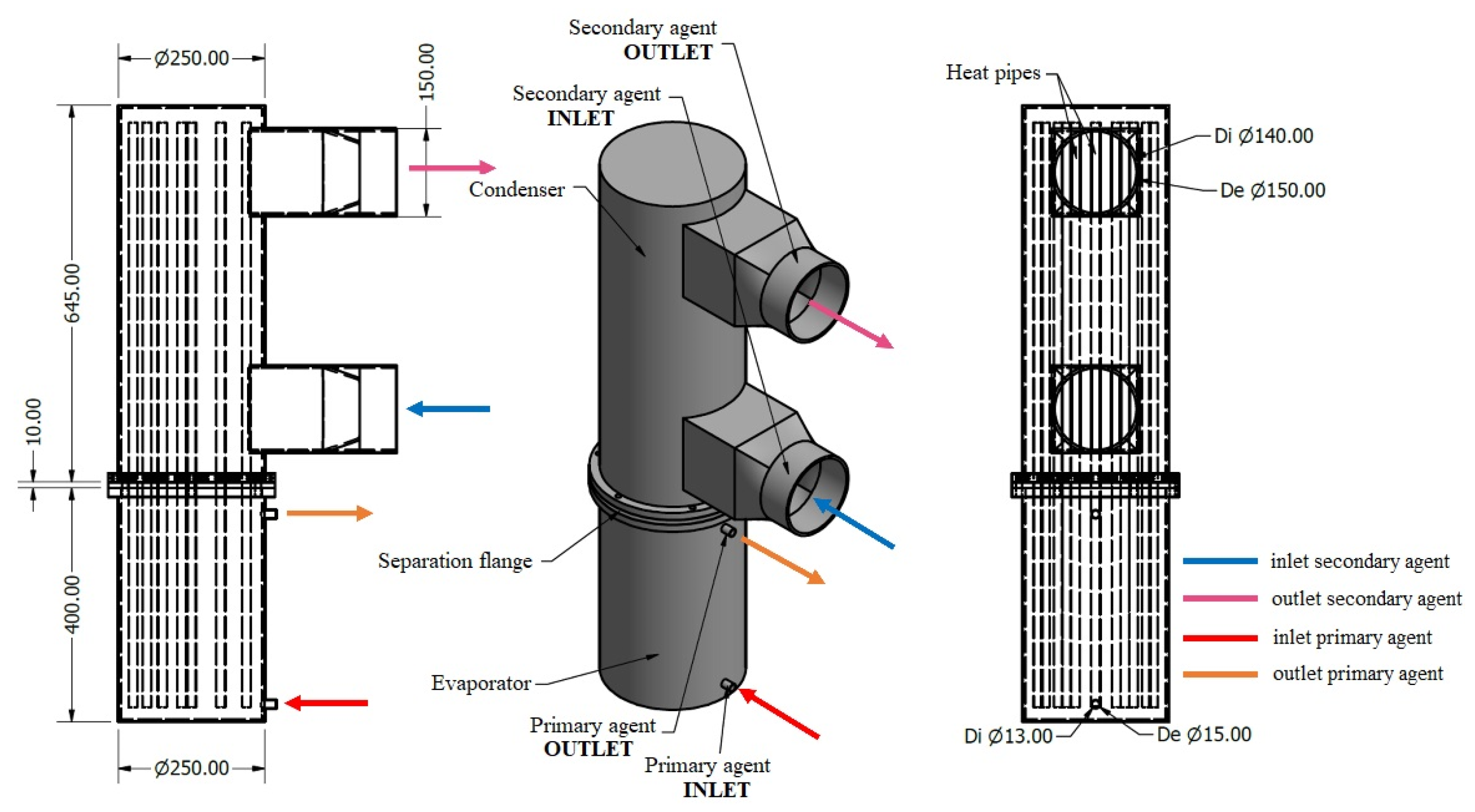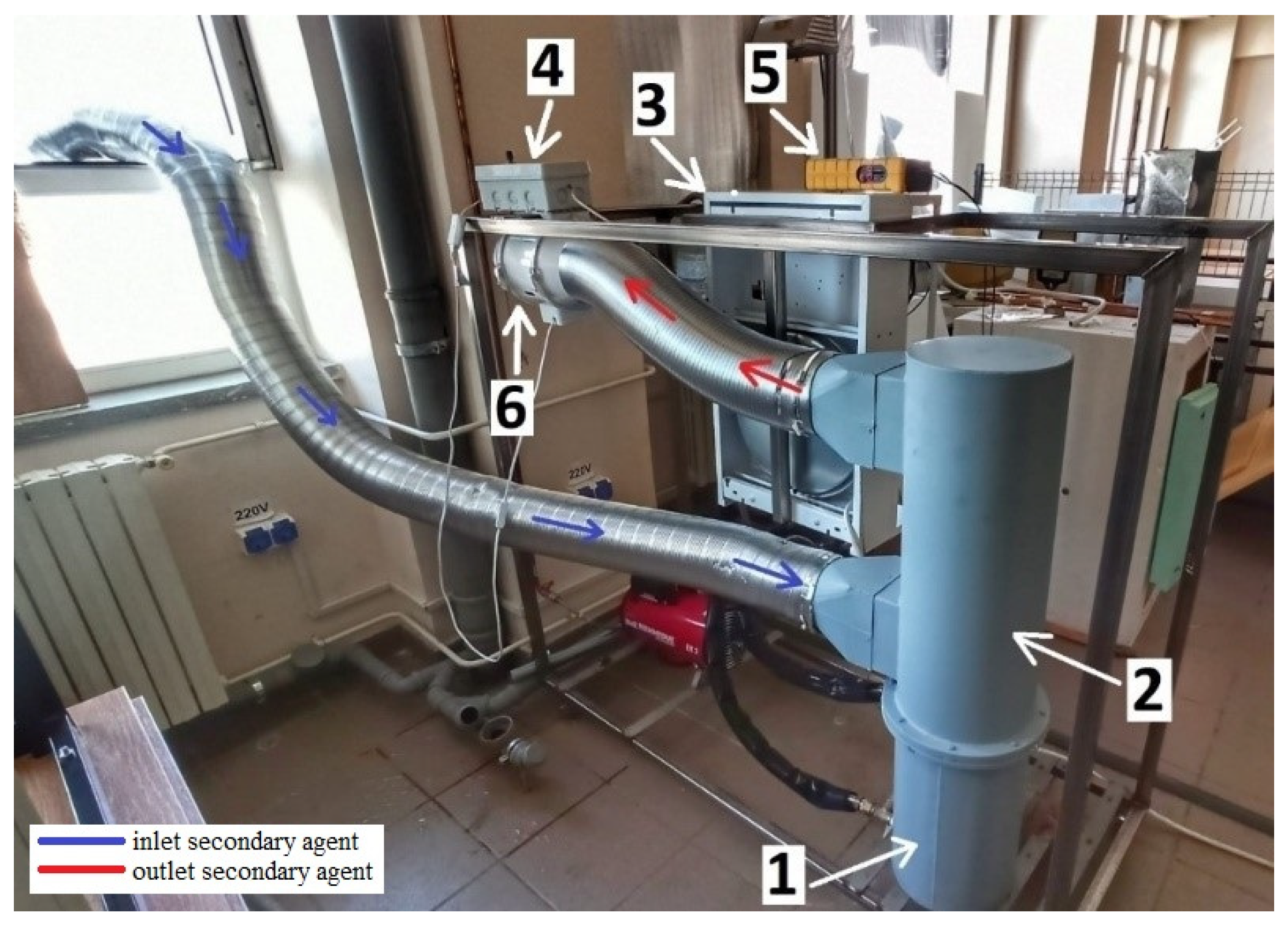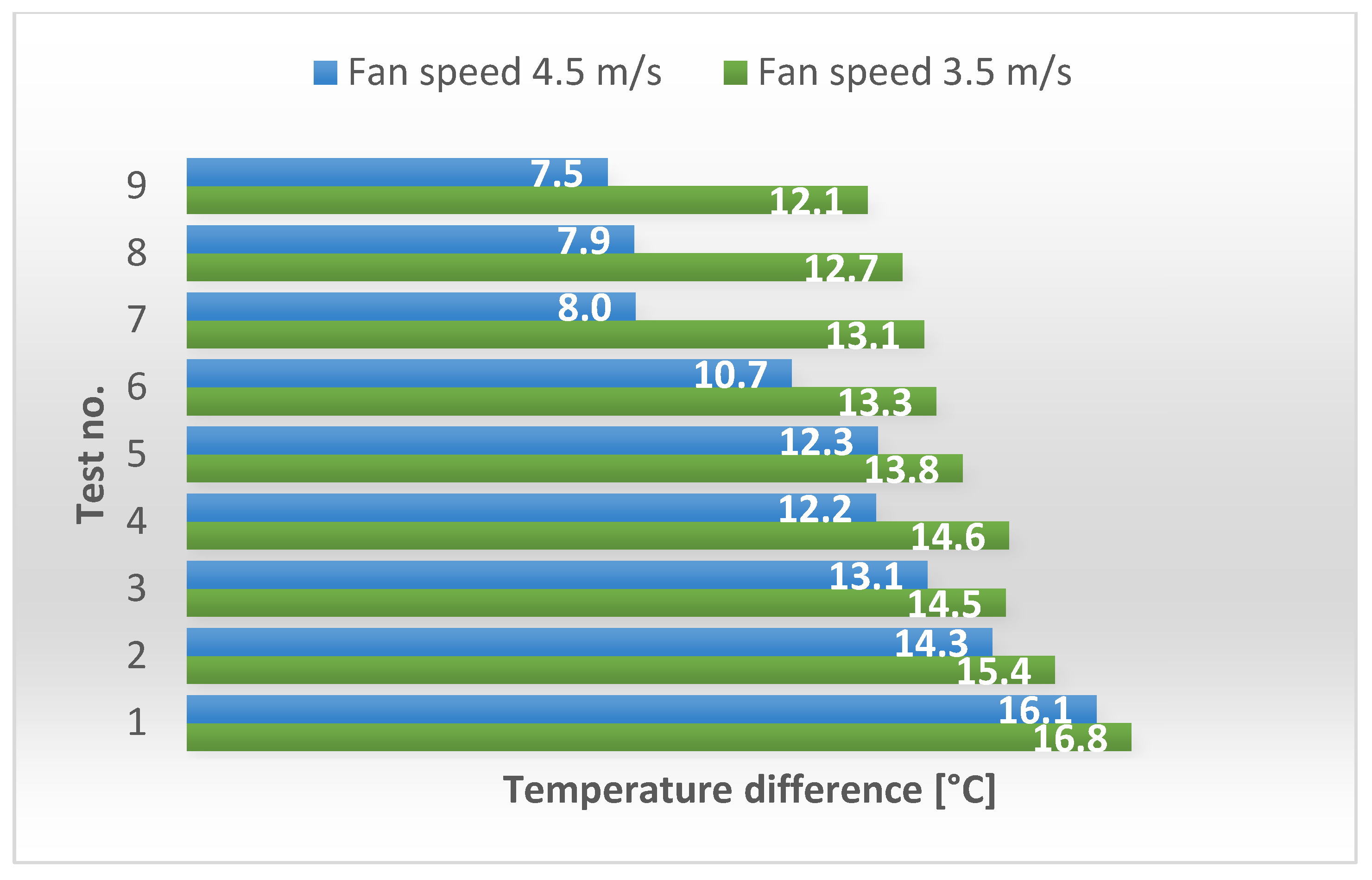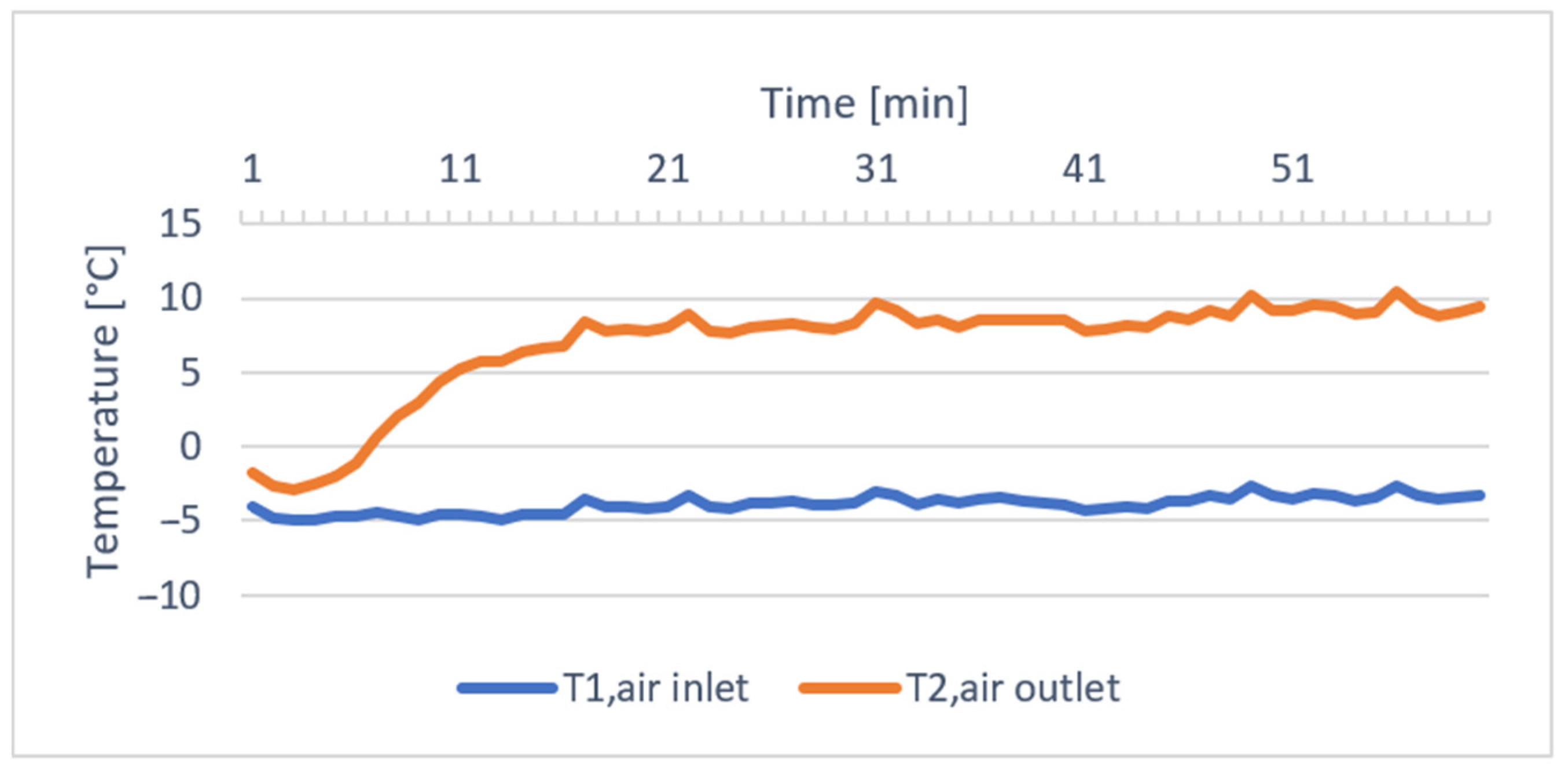Experimental Investigation of a Water–Air Heat Recovery System
Abstract
:1. Introduction
2. Materials and Methods
2.1. The Design of the Heat Pipe Heat Recovery System
2.2. Experimental Setup
2.3. Tests Performed
3. Results and Discussion
3.1. Experimental Results
3.2. The Efficiency of the Equipment
4. Conclusions
Author Contributions
Funding
Institutional Review Board Statement
Informed Consent Statement
Data Availability Statement
Conflicts of Interest
Nomenclatures
| HPHE | Heat pipe heat exchanger |
| PCM | Phase change material |
| T1,air | Average temperature of air at the inlet of the condenser [°C] |
| T2,air | Average temperature of air at the outlet of the condenser [°C] |
| Q | Quantity of heat [W] |
| CEv | Heat capacity rate of the evaporator |
| CCo | Heat capacity rate of the condenser |
| T1,water | Average temperature of water at the inlet of the evaporator [°C] |
| T2,water | Average temperature of water at the outlet of the evaporator [°C] |
| mEv | Mass flow rate of water [kg/h] |
| Cp,Ev | Specific heat of water [kg/m3 K] |
| ε | Efficiency |
| k | Average (mean) overall heat transfer coefficient [W/m2 K] |
| S | Area of heat exchange [m2] |
| Logarithmic mean temperature difference [°C] |
References
- IEA (International Energy Agency). Global Energy Review: CO2 Emissions in 2021; IEA: Paris, France, 2022. [Google Scholar]
- IEA (International Energy Agency). Net Zero by 2050; IEA: Paris, France, 2021. [Google Scholar]
- Firth, A.; Zhang, B.; Yang, A. Quantification of global waste heat and its environmental effects. Appl. Energy 2019, 235, 1314–1334. [Google Scholar] [CrossRef]
- Miró, L.; Brückner, S.; Cabeza, L.F. Mapping and discussing Industrial Waste Heat (IWH) potentials for different countries. Renew. Sustain. Energy Rev. 2015, 51, 847–855. [Google Scholar] [CrossRef]
- Kuah, C.T.; Koh, Q.Y.; Rajoo, S.; Wong, K.Y. Waste heat recovery research—A systematic bibliometric analysis (1991 to 2020). Environ. Sci. Pollut. Res. 2023, 30, 72074–72100. [Google Scholar] [CrossRef] [PubMed]
- Sreejith, K.; Varghese, B.; Das, D.; Devassy, D.; Harikrishnan, K.; Sharath, G.K. Design and Cost Optimization of Plate Heat Exchanger. Int. J. Adv. Eng. Res. Sci. 2014, 4, 43–48. [Google Scholar]
- Men, Y.; Liu, X.; Zhang, T. A review of boiler waste heat recovery technologies in the medium-low temperature range. Energy J. 2021, 237, 121560. [Google Scholar] [CrossRef]
- Xie, C.-Y.; Tao, H.-Z.; Li, W.; Cheng, J.-J. Numerical simulation and experimental investigation of heat pipe heat exchanger applied in residual heat removal system. Ann. Nucl. Energy 2019, 133, 568–579. [Google Scholar] [CrossRef]
- Jouhara, H.; Khordehgah, N.; Almahmoud, S.; Delpech, B.; Chauhan, A.; Tassou, S.A. Waste heat recovery technologies and applications. Therm. Sci. Eng. Prog. 2018, 6, 268–289. [Google Scholar] [CrossRef]
- Jouhara, H.; Almahmoud, S.; Brough, D.; Guichet, V.; Delpech, B.; Chauhan, A.; Ahmad, L.; Serey, N. Experimental and theoretical investigation of the performance of an air to water multi-pass heat pipe-based heat exchanger. Energy J. 2021, 219, 119624. [Google Scholar] [CrossRef]
- Hakim, I.I.; Sukarno, R.; Putra, N. Utilization of U-shaped finned heat pipe heat exchanger in energy-efficient HVAC systems. Therm. Sci. Eng. Prog. 2021, 25, 100984. [Google Scholar] [CrossRef]
- Mahajan, G.; Thompson, S.M.; Cho, H. Experimental characterization of an n-pentane oscillating heat pipe for waste heat recovery in ventilation systems. Heliyon 2018, 4, e00922. [Google Scholar] [CrossRef]
- Burlacu, A.; Sosoi, G.; Vizitiu, R.Ș.; Bărbuță, M.; Lăzărescu, C.D.; Ciocan, V.; Șerbănoiu, A.A. Energy efficient heat pipe heat exchanger for waste heat recovery in buildings. Procedia Manuf. 2018, 22, 714–721. [Google Scholar] [CrossRef]
- Wang, T.-Y.; Diao, Y.-H.; Zhu, T.-T.; Zhao, Y.-H.; Liu, J.; Wei, X.-Q. Thermal performance of solar air collection-storage system with phase change material based on flat micro-heat pipe arrays. Energy Convers. Manag. 2017, 142, 230–243. [Google Scholar] [CrossRef]
- Maraj, A.; Londo, A.; Gebremedhin, A.; Firat, C. Energy performance analysis of a forced circulation solar water heating system equipped with a heat pipe evacuated tube collector under the Mediterranean climate conditions. Renew. Energ. 2019, 140, 874–883. [Google Scholar] [CrossRef]
- Jouhara, H.; Almahmoud, S.; Chauhan, A.; Delpech, B.; Bianchi, G.; Tassou, S.A.; Llera, R.; Lago, F.; Arribas, J.J. Experimental and theoretical investigation of a flat heat pipe heat exchanger for waste heat recovery in the steel industry. Energy J. 2017, 141, 1928–1939. [Google Scholar] [CrossRef]
- Ma, H.; Yin, L.; Shen, X.; Lu, W.; Sun, Y.; Zhang, Y.; Deng, N. Experimental study on heat pipe assisted heat exchanger used for industrial waste heat recovery. Appl. Energy 2017, 169, 177–186. [Google Scholar] [CrossRef]
- Delpech, B.; Axcell, B.; Jouhara, H. Experimental investigation of a radiative heat pipe for waste heat recovery in a ceramics kiln. Energy J. 2019, 170, 636–651. [Google Scholar] [CrossRef]
- Jouhara, H.; Nieto, N.; Egilegor, B.; Zuazua, J.; González, E.; Yebra, I.; Igesias, A.; Delpech, B.; Almahmoud, S.; Brough, D.; et al. Waste heat recovery solution based on a heat pipe heat exchanger for the aluminium die casting industry. Energy J. 2023, 266, 126459. [Google Scholar] [CrossRef]
- Mathew, A.A.; Thangavel, V. A novel thermal energy storage integrated evacuated tube heat pipe solar dryer for agricultural products: Performance and economic evaluation. Renew. Energ. 2021, 179, 1674–1693. [Google Scholar] [CrossRef]
- Wang, Y.; Chen, Y.; Wang, K.; Li, X. Performance evaluation and thermal analysis of heat pipe flue gas waste heat utilization system. Energy Rep. 2022, 8, 210–217. [Google Scholar] [CrossRef]
- Alizadeh, A.; Ghadamian, H.; Aminy, M.; Hoseinzadeh, S.; Sahebi, H.K.; Sohani, A. An experimental investigation on using heat pipe heat exchanger to improve energy performance in gas city gate station. Energy J. 2022, 252, 123959. [Google Scholar] [CrossRef]
- Xue, L.; Ma, G.; Wang, L. Operation characteristics of air–air heat pipe inserted plate heat exchanger for heat recovery. Energy Build. 2019, 185, 66–75. [Google Scholar] [CrossRef]
- Egilegor, B.; Jouhara, H.; Zuazua, J.; Al-Mansour, F.; Plesnik, K.; Montorsi, L.; Manzini, L. ETEKINA: Analysis of the potential for waste heat recovery in three sectors: Aluminium low pressure die casting, steel sector and ceramic tiles manufacturing sector. Int. J. Thermofluid Sci. Technol. 2020, 1–2, 100002. [Google Scholar] [CrossRef]
- Jouhara, H.; Bertrand, D.; Axcell, B.; Montorsi, L.; Venturelli, M.; Almahmoud, S.; Milani, M.; Ahmad, L.; Chauhan, A. Investigation on a full-scale heat pipe heat exchanger in the ceramics. Energy J. 2021, 223, 120037. [Google Scholar] [CrossRef]
- Shafieian, A.; Khiadani, M.; Nosrati, A. Strategies to improve the thermal performance of heat pipe solar collectors in solar systems: A review. Energy Convers. Manag. 2019, 183, 307–331. [Google Scholar] [CrossRef]
- Ali, H.M. Applications of combined/hybrid use of heat pipe and phase change materials in energy storage and cooling systems: A recent review. J. Energy Storage 2019, 26, 100986. [Google Scholar] [CrossRef]
- Diao, Y.; Qi, N.; Wang, Z.; Zhao, Y.; Chen, C.; Wang, Z. Thermal performance analysis of a solar air collection–cascade storage system integrated with micro-heat pipe arrays. Sol. Energy 2021, 224, 1271–1290. [Google Scholar] [CrossRef]
- Rahim, N.C.; Remeli, M.F.; Singh, B.; Moria, H. Designing a Solar Heat Storage System using Heat Pipe and Phase-Change Material (PCM). Adv. Res. Fluid Mech. 2022, 91, 102–114. [Google Scholar] [CrossRef]
- Spriet, J.; McNabola, A. Decentralized drain water heat recovery: A probabilistic method for prediction of wastewater and heating system interaction. Energy Build. 2019, 183, 684–696. [Google Scholar] [CrossRef]
- Nagpal, H.; Spriet, J.; Murali, M.K.; McNabola, A. Heat Recovery from Wastewater—A Review of Available Resource. Water 2021, 13, 1274. [Google Scholar] [CrossRef]
- Hepbasli, A.; Biyik, E.; Ekren, O.; Gunerhan, H.; Araz, M. A key review of wastewater source heat pump (WWSHP) systems. Energy Convers. Manag. 2014, 88, 700–722. [Google Scholar] [CrossRef]
- Culha, O.; Gunerhan, H.; Biyik, E.; Ekren, O.; Hepbasli, A. Heat exchanger applications in wastewater source heat pumps for buildings: A key review. Energy Build. 2015, 104, 215–232. [Google Scholar] [CrossRef]
- Vizitiu, R.S.; Burlacu, A.; Abid, C.; Balan, M.C.; Vizitiu, S.E.; Branoaea, M.; Kaba, N.E. Investigating the Efficiency of a Heat Recovery–Storage System Using Heat Pipes and Phase Change Materials. Materials 2023, 16, 2382. [Google Scholar] [CrossRef] [PubMed]
- Mazhar, A.R.; Liu, S.; Shukla, A. A key review of non-industrial greywater heat harnessing. Energies 2018, 11, 386. [Google Scholar] [CrossRef]
- Vizitiu, R.S.; Burlacu, A.; Abid, C.; Serban, A.; Verdes, M.; Ciocan, V.; Branoaea, M. Experimental investigation on the optimum filling ratio of heat pipes used for heat recovery systems. In Proceedings of the International Conference Building Services and Energy Efficiency 2020, Iasi, Romania, 22–23 October 2020; pp. 154–161. [Google Scholar] [CrossRef]
- Available online: https://www.engineeringtoolbox.com/heat-transfer-coefficients-exchangers-d_450.html (accessed on 23 July 2024).





| Component | Height [m] | Diameter [m] |
|---|---|---|
| Evaporator | 0.400 | 0.250 |
| Condenser | 0.645 | 0.250 |
| Separation flange | 0.010 | 0.300 |
| Heat pipes | 1.000 | 0.015 |
| Diameter inlet/outlet primary agent | - | 0.015 |
| Diameter inlet/outlet secondary agent | - | 0.150 |
| Test No. | Fan Speed 3.5 [m/s] | Fan Speed 4.5 [m/s] | ||
|---|---|---|---|---|
| T1,air—Inlet [°C] | T2,air—Outlet [°C] | T1,air—Inlet [°C] | T2,air—Outlet [°C] | |
| Test 1 | −2.9 | 13.9 | −3.9 | 12.2 |
| Test 2 | −0.4 | 15.0 | 2.4 | 16.7 |
| Test 3 | 1.7 | 16.3 | 4.1 | 17.2 |
| Test 4 | 2.6 | 17.2 | 5.0 | 17.2 |
| Test 5 | 3.8 | 17.6 | 5.9 | 18.2 |
| Test 6 | 4.8 | 18.1 | 8.2 | 18.9 |
| Test 7 | 5.7 | 18.8 | 12.9 | 20.9 |
| Test 8 | 6.6 | 19.3 | 14.6 | 22.6 |
| Test 9 | 7.5 | 19.6 | 15.7 | 23.2 |
Disclaimer/Publisher’s Note: The statements, opinions and data contained in all publications are solely those of the individual author(s) and contributor(s) and not of MDPI and/or the editor(s). MDPI and/or the editor(s) disclaim responsibility for any injury to people or property resulting from any ideas, methods, instructions or products referred to in the content. |
© 2024 by the authors. Licensee MDPI, Basel, Switzerland. This article is an open access article distributed under the terms and conditions of the Creative Commons Attribution (CC BY) license (https://creativecommons.org/licenses/by/4.0/).
Share and Cite
Vizitiu, R.Ș.; Vizitiu, Ș.E.; Burlacu, A.; Abid, C.; Balan, M.C.; Kaba, N.E. Experimental Investigation of a Water–Air Heat Recovery System. Sustainability 2024, 16, 7686. https://doi.org/10.3390/su16177686
Vizitiu RȘ, Vizitiu ȘE, Burlacu A, Abid C, Balan MC, Kaba NE. Experimental Investigation of a Water–Air Heat Recovery System. Sustainability. 2024; 16(17):7686. https://doi.org/10.3390/su16177686
Chicago/Turabian StyleVizitiu, Robert Ștefan, Ștefănica Eliza Vizitiu, Andrei Burlacu, Chérifa Abid, Marius Costel Balan, and Nicoleta Elena Kaba. 2024. "Experimental Investigation of a Water–Air Heat Recovery System" Sustainability 16, no. 17: 7686. https://doi.org/10.3390/su16177686






